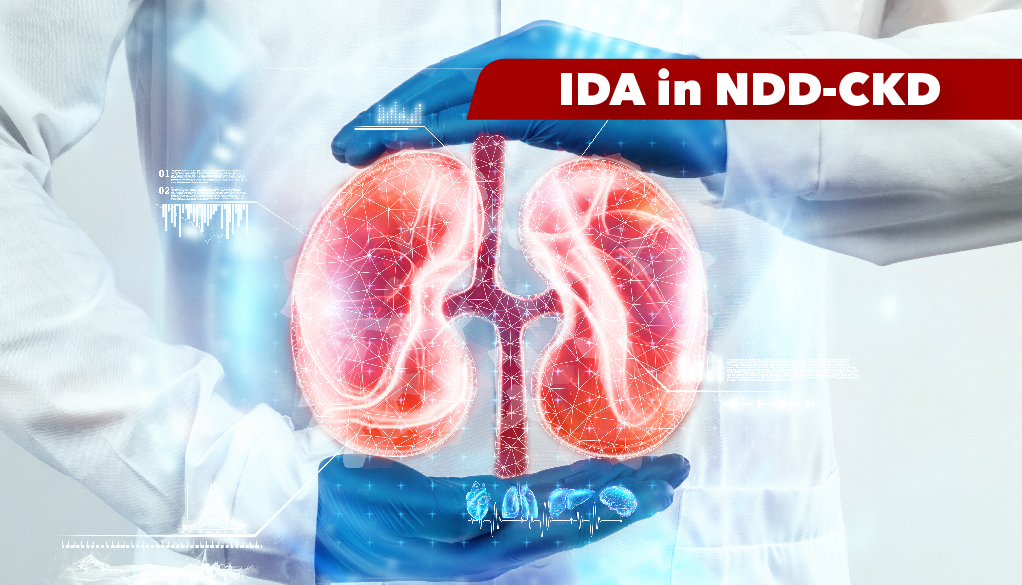The diagnostic and monitoring procedures for iron-deficiency anemia (IDA) in non-dialysis-dependent chronic kidney disease (NDD-CKD) are made challenging by the frequent unreliability of the conventional biomarkers used to identify iron shortage in chronic kidney disease (CKD).1 A variety of iron status biomarkers have been applied in clinical settings.2 Traditional biochemical measures of iron, like serum
iron, transferrin, and serum ferritin, are affected by inflammation, hence they are less reliable markers.2 Assessment of iron status is difficult in the presence of concurrent inflammation because the acute-phase response has contradicting effects on the interpretation of most iron indicators.2
Absolute Vs. Functional Iron Deficiency
Either an absolute or functional iron deficiency may be linked to CKD.3 The administration of erythropoiesis-stimulating agents (ESA), which dramatically raise erythropoiesis, may be connected to functional iron deficiency (ID).3 In this case, the overall body iron stores are sufficient, but the rate at which iron is released from storage into the bloodstream is too slow to supply enough iron to keep up with the enhanced erythropoietic rate brought on by the ESA.3 Additionally, iron-restricted erythropoiesis, a concomitant anemia of chronic disease that is frequently seen in CKD, is linked to an underlying inflammatory state and partially mediated by hepcidin, whose levels have been found to be elevated in the condition.3 It might be challenging to distinguish between functional iron shortage and ESA or anemia caused by chronic disease when there is an “inflammatory block” of available iron.3
Assessment Of Patients With CKD
On initial assessment, all patients with CKD, especially those with an estimated glo-merular filtration rate (eGFR) of 60 mL/min/1.73 m2 or less, should be evaluated for anemia.3 According to WHO guidelines, anemia is de ned as a hemoglobin (Hb) of 13 g/dL or less in men and a Hb of 12 g/dL or less in women.3 Guidelines suggest to monitor Hb concentration only when clinically required, at least once every three months in CKD stages 3-5 NDD, in patients not being treated with an ESA.3 Serum iron, total iron-binding capacity, ferritin, and transferrin saturation (TSAT) measurements are frequently used to detect iron deficiency.3 TSAT is calculated by plasma iron divided by total iron-binding capacity (TIBC) multiplied by 100.3
When the TSAT is 20% and the serum ferritin concentration is 100 ng/mL among predialysis patients, absolute iron shortage in CKD is likely to be present.3 Conversely, serum ferritin concentrations below 30 ng/mL are commonly used to identify iron deficiency anemia in those with normal kidney function.3 Functional iron deficiency is typically characterized by TSAT 20% and raised ferritin levels (as high as 800 ng/mL), as well as ESA-induced functional deficiency and anemia of chronic disease.3 Hematocrit, reticulocyte count, mean corpuscular Hb, and mean corpuscular volume are among the classic biomarkers used in the diagnosis of IDA; many of these measurements are reduced in IDA.4 Iron studies typically reveal a decreased iron level, decreased ferritin, elevated transferrin and TIBC, and decreased TSAT in the presence of absolute iron deficiency.1 The standard cutoffs of serum ferritin at 100 ng/mL and TSAT at 20%, however, appear to be insensitive to identifying iron deficiency.4
These parameters’ inability to distinguish between absolute and functional IDA is another significant drawback.1 For instance, both absolute and functional IDA enhance transferrin.1 Additionally, iron may be stripped o transferrin quicker than it can be mobilized from the iron reserves if a functional iron deficiency arises as a result of a supply/demand imbalance, such as with ESA supplementation.1 This would result in a decline in TSAT.1
BONE MARROW BIOPSY
Many people believe that a bone marrow biopsy is the most accurate way to diagnose IDA.1 However, estimates suggest that up to 30% of bone marrow samples could be unreliable or insufficient for diagnosis, and the quantity of fragments tested has a significant impact on the likelihood of a reliable result.1 The invasiveness of the treatment, as well as the financial and logistical constraints placed on patients, are additional drawbacks.1 Due to these drawbacks, novel serum biomarkers are required to distinguish between different kinds of IDA in CKD patients.1
BIOMARKERS
Several biomarkers have been proposed.1
Regardless of iron storage, patients with CKD usually have high serum ferritin levels because it is an acute-phase reactant.1 Because ferritin synthesis responds to inflammatory cytokines, elevated ferritin levels in CKD are probably the result of underlying systemic inflammation.4 As a result, absolute iron deficiency has a high specific city for low ferritin levels, whereas IDA in chronic kidney disease is not excluded by normal or higher ferritin levels.4
• The transferrin receptor binds ferric iron, and the resulting complex is then taken up by the cell as the soluble transferrin receptor (sTfR).1 The sTfR is then released from the erythroid progenitor cells’ membrane and enters the bloodstream.1 Consequently, the evaluation of sTfR as a possible indication of iron deficiency has occurred.1 The use of sTfR in the assessment of IDA in CKD, however, is not supported by the available evidence.1
• Reticulocyte Hb content (CHr) and the percentage of hypochromic RBCs (HRC%): Additional indirect markers have been taken into account while evaluating IDA.1 In order to reflect the iron available for erythropoiesis in the recent timeframe, HRC% and CHr both estimate the Hb concentration in RBCs.1 Some have suggested using HRC% and CHr in the assessment of IDA in CKD due to their ability to predict iron response.1 HRC%, particularly, is regarded as a cost-effective indicator of iron responsiveness.1 Testing regulations, however, place restrictions on both parameters.1 As erythrocyte maturation is time-sensitive, HRC% must be measured within 6 hours of collection.1
Thalassemia also precludes the use of CHr because it results in alterations comparable to those brought on by an iron de cit.1
• Hepcidin has been investigated as a marker of iron storage and iron responsiveness as well as to distinguish between absolute and functional IDA due to its crucial involvement in iron regulation.4 In a sample of 61 patients with CKD from the Ferinject assessment in patients with IDA and NDD-CKD, hepcidin levels were found to be correlated with ferritin levels (FIND-CKD trial).1 Hepcidin and iron responsiveness, however, did not show any conclusive link.4 These findings imply that hepcidin level measurement has limited value in assessing IDA in CKD.4
• Plasma neutrophil gelatinase-associated lipocalin (NGAL) has been linked to acute kidney injury, as a biomarker of in ammation and an independent predictor of the development of kidney disease.1 NGAL also has an impact on iron sequestration.1 The extracellular concentrations of iron may increase while NGAL is in its free form, but they may decrease when it is bound.1 It was discovered that NGAL values below 394 ng/mL strongly correlated with TSAT and had a higher sensitivity and specificity for detecting decreasing iron reserves in CKD than ferritin values above 500 ng/mL.1 Despite the fact results have been encouraging, more research is needed before NGAL can be suggested as a reliable indicator of iron deficiency in CKD.1
The use of traditional biomarkers of IDA in NDD-CKD is appropriate, according to the most recent literature, especially in light of the absence of other reliable biomarkers.1 Further research is needed in the area of novel serum biomarkers for IDA in NDD-CKD.1
References:
- Batchelor EK, Kapitsinou P, Pergola PE, et al. Iron Deficiency in Chronic Kidney Disease: Updates on Pathophysiology, Diagnosis, and Treatment. J Am Soc Nephrol. 2020;31(3):456-468. Doing:10.1681/ASN.2019020213.Pub 2020.
- Ueda N, Takasawa K. Impact of Inflammation on Ferritin, Hepcidin and the Management of Iron Deficiency Anemia in Chronic Kidney Disease. Nutrients. 2018;10(9):1173.doi:
10.3390/nu10091173. - Gafter-Gvili A, Schechter A, Rozen-Zvi B. Iron Deficiency Anemia in Chronic Kidney Disease. Acta Haematol. 2019;142(1):44-50. doi: 10.1159/000496492. Pub 2019.
- Pergola PE, Fishbane S, Ganz T. Novel Oral Iron Therapies for Iron Deficiency Anemia in Chronic Kidney Disease. Adv Chronic Kidney Dis. 2019;26(4):272. doi: 10.1053/j.ackd.2019.05.002.


